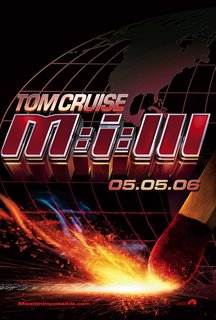Movie Review : The DaVinci Code
 (picture curtesy of TheDaVinci Code.com)
(picture curtesy of TheDaVinci Code.com)
Dan Brown’s “The DaVinci Code” was one of those books that I actually managed to finish within a single sitting. From the first moment that I opened the cover, I was instantly hooked in by the fast paced plot and interesting premise. It also didn’t hurt that the short chapters in the book had a cinematic feel to it that made it easy to visualize the story in a visual medium. When it was announce that a feature film was being released based on the novel, I already had my own expectations of what the movie could be like based on my earlier read. As I entered the cinema to watch the “The DaVinci Code”, I was anxious to see how closely my expectations was with the actual product directed by Ron Howard.
In “The DaVinci Code”, Tom Hanks plays the role of Robert Langdon, a Harvard symbologist, who was in Paris delivering a lecture when he becomes embroiled in a murder investigation headed by Inspector Fache (Jean Reno). The victim of the murder, Louvre museum curator Jacques Sauniere (Jean-Pierre Marielle), was found with symbols drawn all over his body by himself as he bled to death after being shot by a hooded albino monk Silas (Paul Bettany). What Langdon didn’t know was that one of the messages that Sauniere left behind was his name which Fache took as a clue as to the identity of the curator’s killer.
Enter Sophie Neveu (Audrey Tautou), a cryptologist for the French police and later revealed as Sauniere’s granddaughter, who warns Langdon of Fache’s intentions. After out-witting the inspector and his team of police personnel, Langdon and Sophie started to try to figure out the message that was left by the dead curator for both of them. The message they receive starts them in a journey to decipher clues that would explain why Sophie’s grandfather was killed. Their journey takes them from the bowels of the Denon Wing of the Louvre, to a local office of the Swiss Bank then to the French country side followed then by a visit to London before ending at the Rosslyn Chapel in Scotland within a 24 hour period.
Along the way, the pair also picked up Sir Leigh Teabing (Ian McKellen) to assist them to uncover the truth surrounding the Holy Grail whose secret Sauniere died to protect. As the trio traveled to escape an unrelenting Fache, they were also pursued by the murderous monk, Silas, on the orders of Bishop Aringarosa (Alfred Molina) who is trying to destroy everything linked to the secret that was being unraveled with the first murder. After a fair amount of twist and turns in the story, the real truth regarding the secret that Sauniere died to protect was finally revealed and justice summarily meted out to those who deserve it.
Working from a literal adapted screenplay written by Akiva Goldsman, Ron Howard’s “The DaVinci Code” stayed mostly true to Dan Brown’s source material. Other than minor changes to some of the characters, the film follows the original book almost religiously to an extent. Unfortunately for this movie, what worked magically on the printed medium seems to be lost in this meandering adaptation. The film did not successfully convey the sense of urgency and desperation that made the original novel such a page turner. While the movie doesn’t actually grinds to a halt at the more slower scenes but it did feel that the movie would be better served by adding a little more sense of urgency in it. There were point in the movie that you really feel the 140 minutes running time for this movie.
The normally brilliant Tom Hanks seems to be woefully miscast in the role Robert Langdon. His portrayal of the character came off too clinical and measured that made the character less engaging for the audience to invest their time empathizing with his plight. The painfully glaring omission of any explanation for the character’s motivation also helped little to build a character that the audience can identify with. This was true not only for Tom Hanks character but also the other characters in this movie. By glossing over the character motivations that made these characters so alive in the printed medium, the audience were left with fairly uninteresting and superficial copies. Fortunately for us, Ian McKellen’s wonderfully proficient portrayal of Sir Leigh Teabing saves audiences from falling asleep too deeply mid way into the movie. Applying the “playfully-eccentric-but-with-great-power” acting method that he perfected while playing Gandalf in the Lord of The Rings trilogy, Sir Leigh Teabing becomes the most memorable character in this movie that doesn’t have to strip naked and flog himself with a whip for penance.
“The DaVinci Code” is by no means a total failure. The film was an involved and engaging story especially to those who might have not read the original book. Those who have set their own expectations based on their own reading of the book might find themselves disappointed if not outraged by the lack of the sense of urgency and human failings that made the original a true page turner. Too many of the characters were portrayed without the character motivations that would help them come alive on screen. The decision to gloss over such an important character component was strange choice to make given the ample opportunities that the 148 minutes running time gave them to develop these characters. In the end we are left with a serviceable summer blockbuster release that I felt full of unfulfilled promises and unrealized potential.











